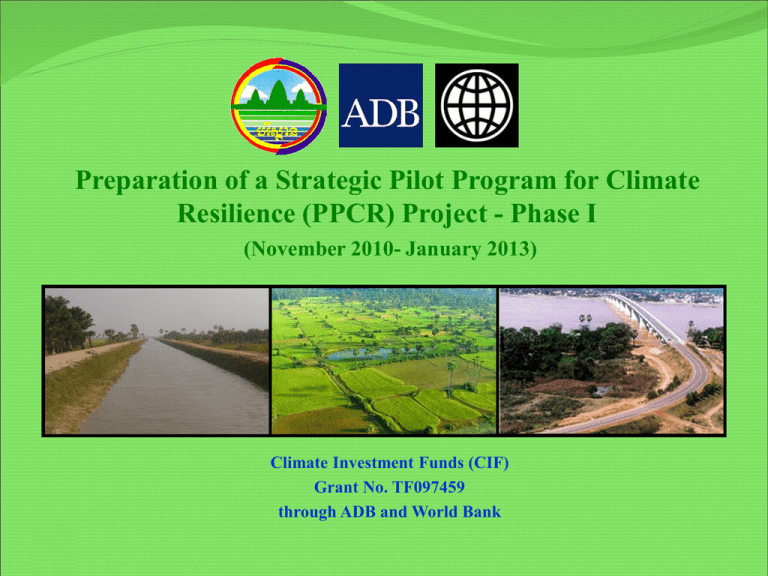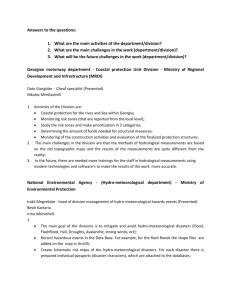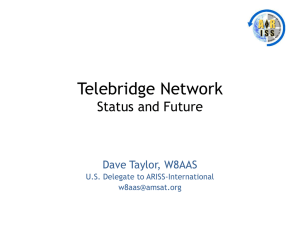
Preparation of a Strategic Pilot Program for Climate
Resilience (PPCR) Project - Phase I
(November 2010- January 2013)
Climate Investment Funds (CIF)
Grant No. TF097459
through ADB and World Bank
Technical Assistance on Science-Based Adaptation Planning
and Outreach (Hydro-meteorological Information)
Climate Change Resilience (PPCR) Project – Phase 1
Inception Meeting,
Phnom Penh, Cambodia
April 23-24, 2012
www.CamMoE-CCD-PPCR.org.kh
www.pilot-program.blogspot.com
Presented by:
Jorma Koponen and Sok Saing Im
2
Presentation Outline
1.
Introduction: Hydro-meteorological network and climate
change
2.
Current status of hydro-meteorological network
infrastructure
3.
Hydro-meteorological network rehabilitation
4.
Scalability, quality, and sharing of data
5.
Current network roles and responsibilities
6.
Discussion Questions
www.CamMoE-CCD-PPCR.org.kh
www.pilot-program.blogspot.com
3
Introduction:
Hydro-meteorological Network and Climate Mitigation
1.
Climate change means that weather events are becoming increasingly unpredictable
2.
Over 16 million people in Cambodia affected by climate and weather related disasters in the last
20 years
3.
$521 million in damages incurred since 1990 (EM-DAT: The OFDA/CRED International Disaster Database;
World Development Indicators, World Bank)
4.
Extensive and persistent data gaps exist for all of rainfall, water level, and rates of flow; making
mitigation of climate and weather events difficult
www.CamMoE-CCD-PPCR.org.kh
www.pilot-program.blogspot.com
4
Current Status:
Hydrological Network Infrastructure
200 manual rainfall stations in Cambodia: approximately 10 of which are delivering
continuous time-series data
www.CamMoE-CCD-PPCR.org.kh
www.pilot-program.blogspot.com
5
Hydrological Network Infrastructure
123 hydrological stations, 97 of which are water level stations
www.CamMoE-CCD-PPCR.org.kh
www.pilot-program.blogspot.com
6
Hydro-meteorological
Network Infrastructure
The MRC maintains a series of
meteorological and hydrological stations in
Cambodia as part of its regional hydrometeorological network
The Ministry of Agriculture, Forestry and
Fisheries (MAFF) operates a limited
number of climate stations
Most stations are poorly equipped and
lack adequate maintenance
Very fragmented geographical coverage
© Hatfield Consultants. All Rights Reserved.
7
Scalability, Quality, and Sharing of Data:
Knowledge Management and Information Sharing
1.
Raw data are collected with very little screening
2.
Data processing procedures not strictly followed at stations with backwater effects
3.
Quality of flow data not always managed properly
4.
Hydro-meteorological information used for little else than flood forecasting
5.
Compatibility of hydro-meteorological data collected in Cambodia with data collected in
neighboring countries is unknown
6.
Data sharing is occurring as part of the MRC, but also as part of partnerships that exist
between remote sensing and hydrological organizations
7.
Data sharing with the public is occurring with respect to flood forecasting, but for little else
8.
An intermediate mechanism for interpreting El Niño/La Niña forecasts and converting them
into locally usable information is lacking
www.CamMoE-CCD-PPCR.org.kh
www.pilot-program.blogspot.com
8
Rehabilitation:
Hydro-meteorological Network Infrastructure
1.
Doppler weather radar station construction in Phnom Penh (MOWRAM) is complete and
operational
2.
Only those MRC stations along the Mekong mainstream are supported by the MRC
Appropriate Hydrological Network Improvement Project (AHNIP)
3.
The Mekong Hydrological Cycle Observing System (HYCOS) Project is working on
rehabilitation of stations until 2013
www.CamMoE-CCD-PPCR.org.kh
www.pilot-program.blogspot.com
9
Roles and Responsibilities:
Hydro-meteorological Network Operation
1.
2.
3.
Department of Hydrology and River Works (DHRW), MOWRAM
–
Hydrological data collection
–
Hydrological network operation and management
–
Data processing, analysis and dissemination
–
Flood and weather forecasting for DOM
Department of Meteorology (DOM), MOWRAM
–
Meteorological data collection, cataloguing and dissemination
–
Equipment
–
Capacity building and training of Provincial staff
Provincial authorities
–
4.
5.
6.
Allocating land and finances for staffing the Meteorological stations
There is a lack of qualified technicians for repairing and maintaining stations
Most rainfall stations are manual: installations may not follow consistent standards
Data sharing is mandated and described by the Water Law
www.CamMoE-CCD-PPCR.org.kh
www.pilot-program.blogspot.com
10
Discussion Questions
1.
How do you currently use hydromet data (e.g., for water resources management, irrigation
development, disaster management, vulnerability analysis, hydropower development, fisheries
management)?
2.
What needs to be done to improve the availability and quality of hydromet data?
3.
How are climate change data and information taken into consideration in planning and
investments (e.g. infrastructure development)?
4.
What kind of support do you require to be able to utilise climate change information for planning
and decision-making?
www.CamMoE-CCD-PPCR.org.kh
www.pilot-program.blogspot.com
11
Thank you!
For further information contact:
Sok Saing Im
Climate Change/Environment/NRM Specialist
HATFIELD CONSULTANTS PARTNERSHIP
sok.saingim@yahoo.com
Mobile phone: 011 607890
Sokhem Pech, Team Leader
Manager of International Development Group
HATFIELD CONSULTANTS PARTNERSHIP
North Vancouver, BC, CANADA
Office phone +1.604.926.3261
Mobile phone +1.778 389 8736
spech@hatfieldgroup.com
www.hatfieldgroup.com
www.CamMoE-CCD-PPCR.org.kh
www.pilot-program.blogspot.com
12









